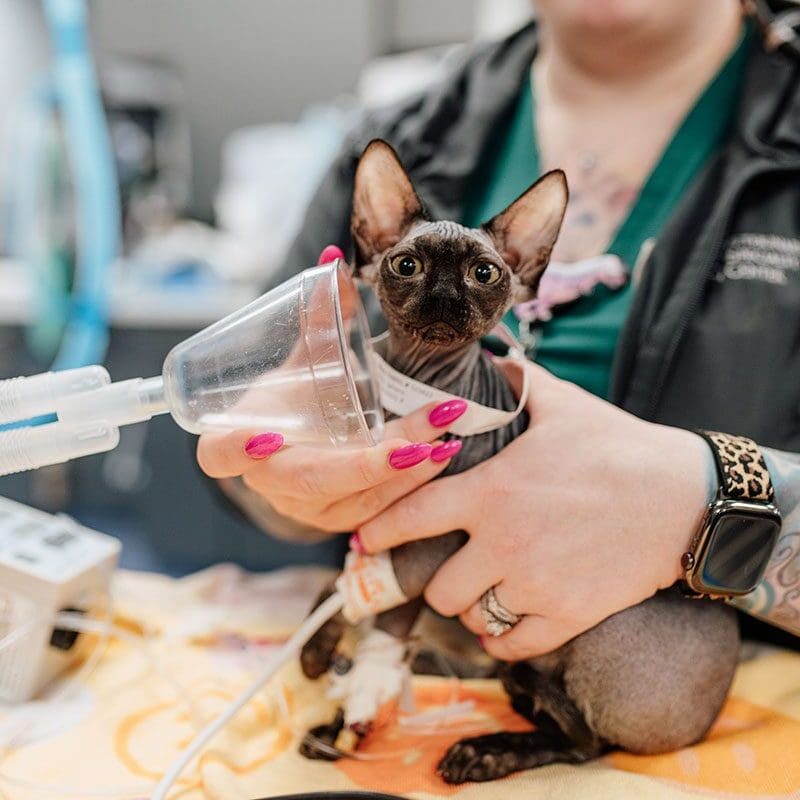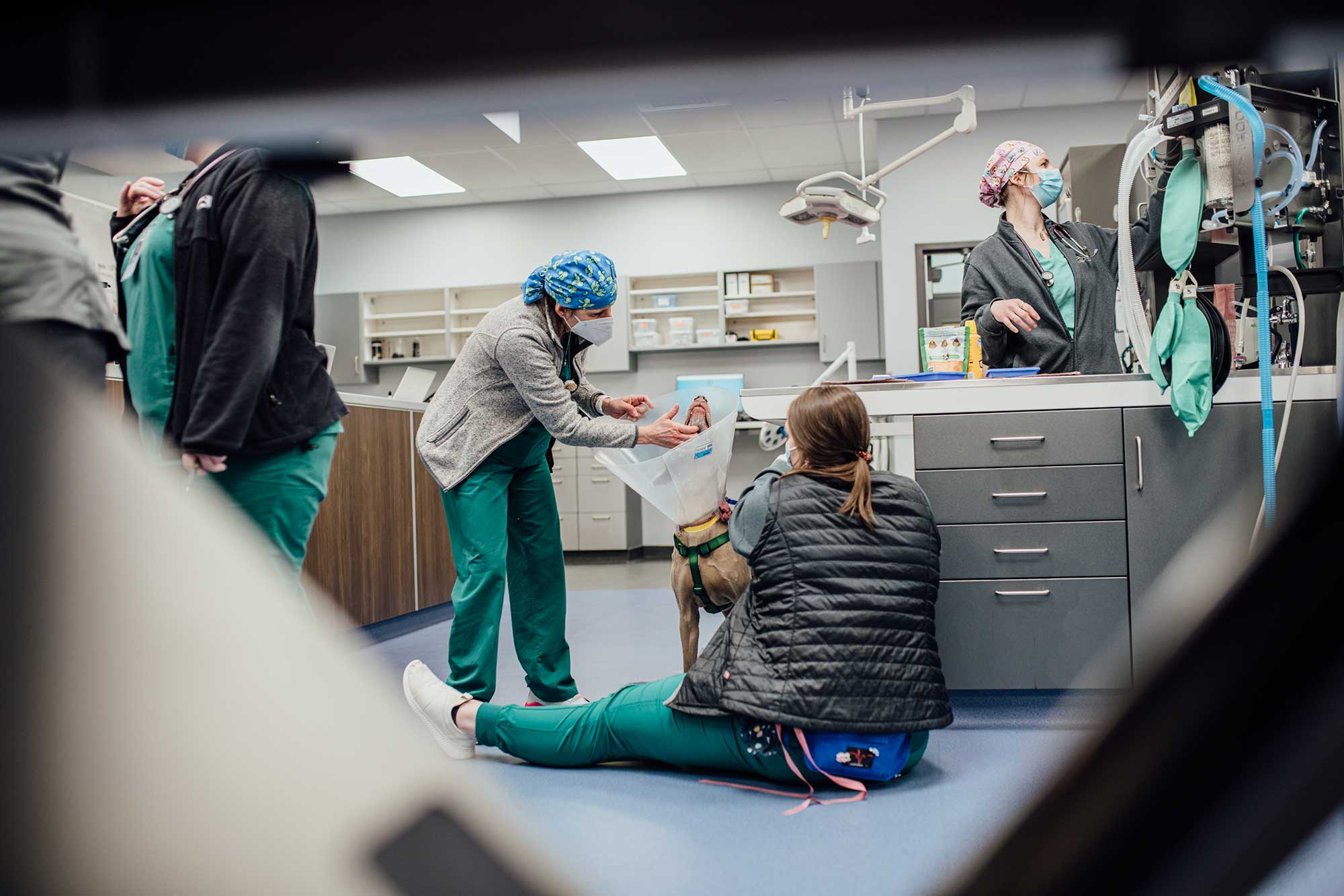Chronic ear disease is a common problem in dogs and cats. Despite appropriate care, ear infections can progress to marked inflammation of the external and middle ear. This progression can lead to proliferative changes or mineralization in the ear canal and eventually complete occlusion of the canal. Severe end-stage ear infections are associated with middle ear infections, pain, and hearing loss in many dogs.


Once ears have become ‘end stage,’ medical management becomes futile and surgical intervention is indicated. Often a CT scan will be recommended prior to surgery to ensure the ear canal is truly “end-stage” and to rule out other problems, such as a tumor. Total ear canal ablation is a surgical procedure in which the diseased tissue of the external and middle ear is removed. This allows a pain-free ear that does not require long-term medical management.
Ear disease in dogs and cats should be treated medically before aggressive surgical intervention is recommended.
Procedure
-
General anesthesia is required for total ear canal ablation.
-
The affected ear is clipped and prepared for sterile surgery.
-
The incision is made around the opening of the ear canal and sometimes continues along the canal.
-
The ear canal is dissected free and removed.
-
The middle ear is then opened to allow the surgeon to remove debris from the middle ear. The eardrum has always been ruptured and is absent in these patients.
-
A culture of the contents of the middle ear is often submitted.
-
The middle ear and the excision site from the outer ear are thoroughly flushed with sterile saline.
-
Some surgeons use a drain to provide drainage after surgery. This is not necessary in every case.
-
The incision is then closed, leaving no opening to the ear.
-
A bandage or Elizabethan collar is used postoperatively to prevent self-trauma at the surgery site.


Indications for Ear Canal Ablation
Total ear canal ablation is indicated for dogs and cats with chronic end-stage outer ear canal and middle ear infections. In some cases, patients with tumors of the ear canal are also candidates for a total ear canal ablation.
Postoperative Care
Incisions take 10-14 days to heal–sutures should be removed in 10-14 days. The incisions should be inspected daily and excessive redness, swelling or discharge should be reported to your pet’s surgeon. Placing an ice compress over the affected ear should help reduce some of the swelling. This cold pack should be applied for 5 minutes 2-3 times per day for the first 3 days. If a drain or bandage is in place, you should follow your surgeon’s advice for removal. The Elizabethan collar should be left in place until the sutures have been removed. Your pet’s activity level should be restricted during the first 2 postoperative weeks.
Results of lab work, such as cultures and biopsies are usually available in 5-10 days; you should contact your pet’s surgeon to discuss the results of these tests and any follow-up instructions that might be necessary. Antibiotics that are prescribed should be given until finished. Your pet’s surgeon may change or extend the course of antibiotic treatment based on the results of cultures taken during surgery. Other, more specific, instructions will be given to you upon release of your pet from the hospital.
Potential Complications
-
Due to the advanced state of ear disease and infection and the aggressive nature of the surgical procedure, there are possible complications. The most frequent complication is paralysis of the facial nerve. This is more frequent in patients with a large amount of scar tissue around the ear canal and is a sequel to the dissection of this nerve off of the canal. Facial nerve paralysis manifests as an inability to blink, a droopy eyelid, and a droopy lip. Often facial nerve paralysis is temporary taking 21 days to resolve. Treatment is usually with the application of an eye lubricant to prevent drying of the cornea.
-
Usually, the eye lubricant needs to be applied for 2-3 weeks.
-
Some animals may get a prominent third eyelid, a small pupil, and potentially some rapid eye movement on the affected side. This is also usually a temporary change that dissipates in a few weeks and is more common in cats.
-
Other complications are less frequent and include alteration in balance and coordination, a head tilt, bleeding, infection of the incision, and recurrent middle ear infections causing draining tracts.
-
Infection often requires treatment for multiple weeks and may necessitate strong antibiotics. Most patients have been previously treated with multiple rounds of antibiotics and have resistant strains of bacteria present.
-
Hearing does not return. Most patients who need an ear ablation already have diminished hearing and it will not improve after surgery. If you notice any abnormalities, you should contact your regular veterinarian or your pet’s surgeon.
Prognosis


Most pets with severe ear disease necessitating ear ablation have a great response to surgery. Pets are pain-free, odor-free, and infection-free. Occasional complications are usually not severe.
Ear diseases in dogs and cats should always be treated medically before aggressive surgical intervention is recommended. The aftercare may require prolonged medications (antibiotics) but long-term results are often excellent. Surgery is an excellent way to eliminate the chronic pain and infections that result from end-stage ear disease.

